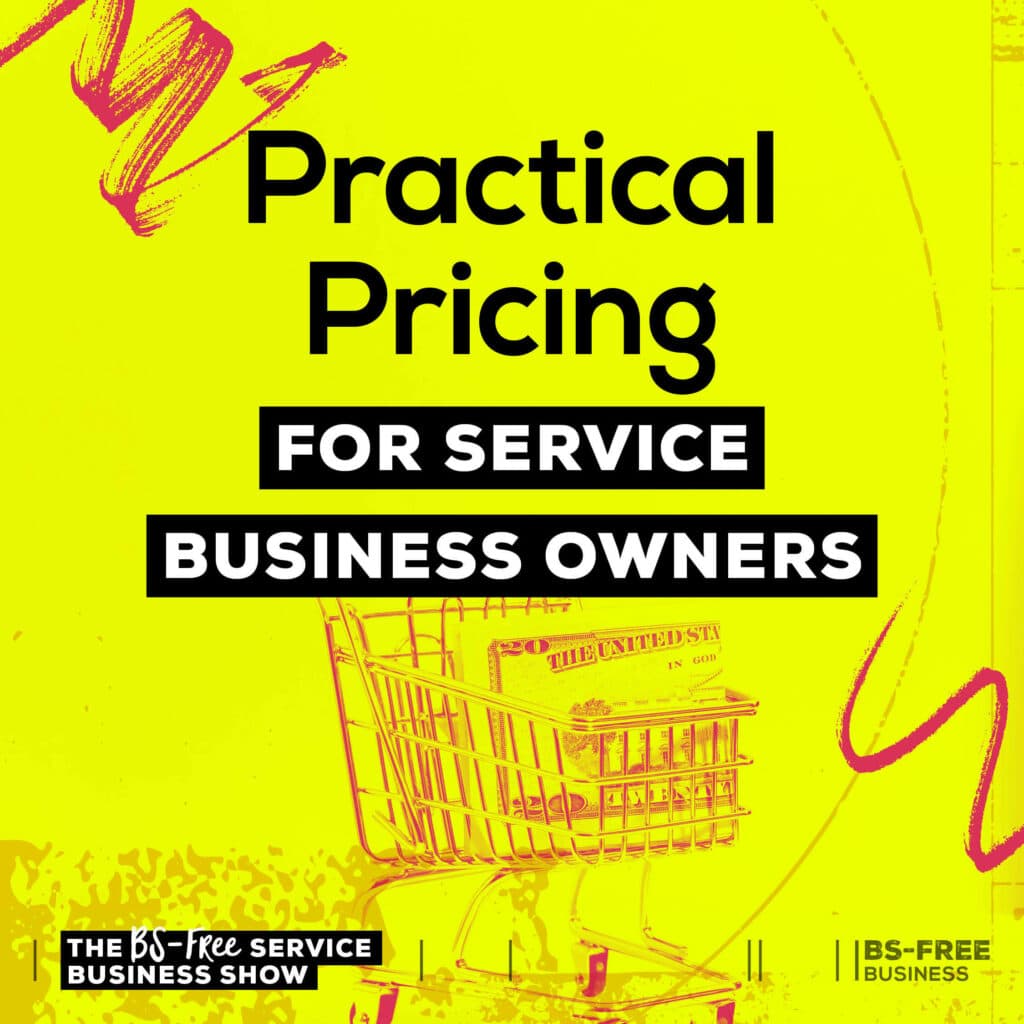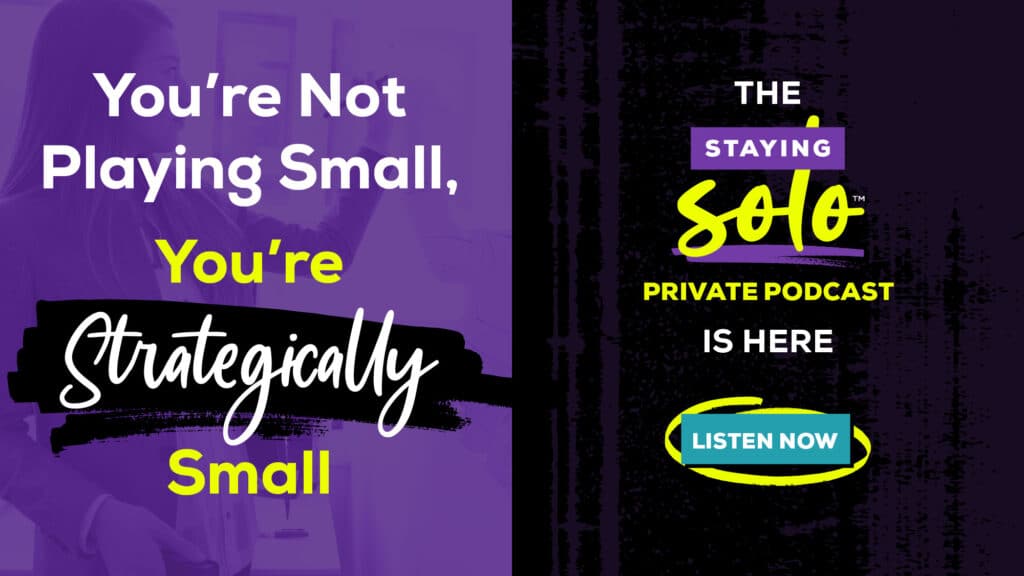
Search the site:
Practical Pricing for Service Business Owners
Pricing is one of the most critical yet complex parts of being a service business owner. It impacts everything from the types of clients you work with to how much money you can pay yourself and even how you feel about your work. In this episode, I’m sharing a practical and proven approach to pricing for service business owners.
As a seasoned service business owner, I know all too well what a rollercoaster it can be to price your services. In working with service business owners, pricing is one of the areas in which they need the most input and support.
This is totally understandable, as so much of the pricing advice is supremely unhelpful. It lacks nuance and is full of platitudes like “charge what you’re worth” or “just raise your prices.”
Plus, there’s no separating pricing your services from your money scripts, stories, models, motivation and mindset. With all those layers, it’s never as simple as raising your prices or charging your worth.
In this episode, we’re taking a practical look at the pricing of services, including what your clients wish you knew, how to set realistic prices, and much more.
The Psychology of Pricing, Trust and Your Clients
You can set your prices however you’d like, but if your clients won’t pay that price, you’ll struggle more than necessary. You need to understand what’s happening for your clients and factor that into your pricing decisions.
Typically, when we talk about the psychology of pricing in the online business world, we focus on scammy shortcuts to manipulate your clients. I don’t want to talk about hidden pricing, charm pricing, high ticket pricing, or anything of that nature, but instead, how your potential clients may perceive your pricing.
This isn’t about tricks but what research tells us about how your clients buy.
In the current climate, research from Deloitte shows that consumers are concerned about rising prices. About 75% of consumers are “concerned about rising prices for everyday purchases.” I’m sure that’s unsurprising to all of you, as you’re feeling the impacts of inflation daily.
Overall, consumers are under strain and are concerned about their financial health, including their savings and level of debt.
Our businesses operate against this backdrop, and the Deloitte report found that “consumer sentiment around inflation goes beyond mere concern.” As prices have risen, there’s a perception that “companies themselves are also at fault.” This has led to “a clear lack of trust brewing,” this “unfair pricing sentiment is correlated with weaker spending intentions.”
In short, your potential clients are likely weary at the moment, meaning you need to focus on building trust like never before.
Research from PwC referred to trust as “a currency, altering loyalty and buying decisions for customers.” In the survey, (91%) of customers say they would buy from a company that gained their trust. Of that group, 14% say they would buy significantly more. On the other hand, of the 71% of customers who say they would buy less if a company lost their trust, a whopping 73% say they would spend significantly less.”
While this is primarily consumer research related to large companies, it’s incredibly relevant to all buying decisions in an uncertain economy. Your potential clients are looking to you to provide context for your pricing so they understand the value you deliver and don’t feel like you’re unfairly profiting.
Remember that when it comes to the pricing of services, your clients may have wildly different ideas of how much your services may cost. Research from Anderson and Simester indicates that many consumers have poor price knowledge, so they rely on pricing cues.
Pricing cues guide buying decisions, such as sale signs, prices ending in 9, and pricing guarantees. For service businesses, these practices aren’t particularly helpful. Still, you can provide pricing cues to your customers by ensuring they have insight into the offer and a general idea of pricing.
Think about it from your potential client’s perspective. Who will they trust more if they don’t have a good handle on the pricing? The person with no pricing and very little detail, or the person with a straightforward process and a stated starts at price?
Transparency is a compelling signpost that leads to trust from your potential clients and needs to be considered a foundational part of how you price your services.
Evaluating Your Current Pricing
Before we develop a practical approach to pricing your services, we need to look at your current pricing.
To evaluate your pricing, here are a few key questions to explore:
- How much do you currently charge for each of your services?
- Are you selling those services at that price? What’s your close rate with potential clients for each service?
- What services do you sell the most? The least?
- How much does each service cost you to deliver? (Be sure to include any hard costs.)
- Are there any hidden costs you’re not accounting for in your pricing?
There’s zero point in considering raising your prices if you don’t have a good handle on the basics. Your pricing needs to be realistic but not leave you short.
Too often, pricing results from guesswork, not actual costs or time involved. This quickly leads to undercharging, overworking and an inability to pay yourself a professional salary.
Next, we need to do the math:
- What’s your average hourly rate? (Even if you don’t charge by the hour)
- What does your hourly rate need to be?
- How many “billable hours” do you work in a week?
- How much time does it cost to deliver a service?
These numbers give you baseline data to work with as you determine your ideal pricing. (If you need a hand, check out the Profitable Pricing workshop.)
Align Your Pricing with Your Goals
We all have specific goals in our business, including how much we want to pay ourselves and how much we want to work.
If you’re unsure how much you want to pay yourself, check out the Personal Salary Goal Calculator. And if you’re thinking you can keep working at the pace you’re currently working at, I want you to sit with that for a moment. Is that realistic?
Use these questions to explore what would best serve you:
- What if you work with fewer clients at a higher price?
- What if you work with 10% more clients and raise your price by 10%?
- What if you work with more clients and charge 20% more?
- How much less do you need to work?
Again, play with the scenarios to see how small changes to each variable of your number of clients, how much you work and how much you work impacts your ability to reach your goals and have a life.
For example, if you made $70k this year and worked with ten clients to reach that number but want to get to $85k next year, you need to increase revenue by 21.4%.
To achieve that number, you could increase prices:
- By 25% across the board and working with fewer clients
- By 15% and take on one more client
- By 10% and take on two more clients
This is why your pricing needs to be intentional, as you have options, but you also need to consider how your potential price increases impact you AND your clients. If you can’t sell your service at the new price, or your prospective clients feel like you’re overcharging, you’re setting yourself up to struggle.
Remember, the goal is always to strike a balance so you’re serving both yourself and your clients. You need to be compensated like the professional you are but in a way aligned with the market you serve.
The Art of Raising Your Prices
The math is one thing, but then there’s the delicate art of raising your prices.
For many of you, this will feel very uncomfortable and may lead to you avoiding it, but trust me when I say it’s a very unsustainable business move.
Assuming you’ve gone through the process of determining your pricing strategy, the next step is to raise them. I don’t mean that in a cavalier, celebrity entrepreneur-type way, but rather that you have to follow through.
I always recommend an incremental price increase with adequate notice for your existing clients so they have time to plan accordingly. Give them at least 30 days and ideally 60 days when raising your prices.
Also, pick your moment strategically. This is a conversation for when your current clients are delighted, not when they’re stressed out, or the relationship is rocky. Happy clients are happy to pay increased prices, while unhappy ones will likely question if it’s worth it.
For new clients, they’ll get your new price. Put that price on your website and your proposals and use it consistently. Once you book a handful of clients at that price, you’ll be confident to raise the price again until you reach your target price.
Mental Junk About the Pricing of Services
While I touched on this early in the episode, pricing can bring up a lot of mental junk. What comes up for us may all be different, but there are a few common themes in my brain and my clients.
A few things that you may be struggling with:
- Who am I to charge this?
- Am I really worth this?
- Will anyone pay this price?
- Is this price too greedy?
- What will people think of me?
I want to affirm that it’s entirely normal if these are coming up. I’ve been pricing services my entire career, and I still question if my pricing is completely whack.
A recurring pricing conversation in my head is “Who the hell do you think you are?” and “What do I need this money for?”. Neither of which is surprising with my money stories and how I was raised. I’ve done lots of work to understand my relationship with money, including becoming a Certified Practitioner in the Trauma of Money Method, but it still shows up. That said, I’ve never ever regretted raising my prices. Not once. And most of the time, I wish I’d done it sooner.
If you’re still not convinced, most service business owners are NOT the ones in the market charging sky-high prices. (We’ll leave that to the scammy online coaches!) The reality is that most service business owners are not charging nearly enough.
Practical Pricing is About a Win/Win for Everyone
Your pricing of services is a critical part of your overall business success, so I hope you’ve found this look at practical and proven approaches to pricing helpful. In reality, bad advice about pricing is everywhere, and it can get in our heads and hold us back, especially in an uncertain economic climate where buying decisions are more complex.
Focus on doing good work, providing excellent service, and delivering real value to your clients while ensuring potential clients trust you and understand your offer and pricing. Those things alone can and will go a long way to helping you price your services in a way that works for everyone.


I’m Maggie Patterson (she/her), and services businesses are my business.
I have 20+ years of experience with client services, am a consultant for agency owners, creatives, and consultants, and vocal advocate for humane business practices rooted in empathy, respect, and trust.
Read or Listen to the Latest
For Solo Business Owners

Growing a solo service business is tough.
It’s even harder when you’re bombarded with BS advice that steers you away from your values and why you started your business in the first place.
This is the podcast for solo creatives and consultants who want to remain as a team of one and have zero interest in the hustle and grind of typical business teachings.
Subscribe now and never miss an episode.
For Micro Agency Owners
Most podcasts for agency owners obsess over revenue growth as the ultimate success metric.

But here’s the truth: not everyone wants to make millions. Your goal might be to build a sustainable business that lets you have a life and doesn’t run you into the ground.
Join me as I spill my shameless confessions and share everything I’ve learned about building a micro agency that skips the BS of tired and typical agency teachings.
Follow Now on All Major Podcast Platforms








